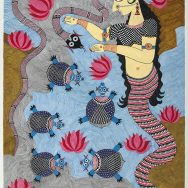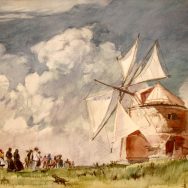The Art, Ecology, and Climate Project
All art is ecological. It is composed of materials that bear ecological histories. It refers to the planet we inhabit in ways that register environmental changes and that shape its audiences’ ecological awareness, thinking, and habits. The Art, Ecology, and Climate Project brings such concerns to bear on Syracuse University’s art collection, at a time of intensifying and unsettling ecological and climatological change. Our research team has curated fifteen online galleries (e-museums) from the collection, each devoted to a different ecological topic, idea, or issue. A general instructor’s guide offers assignments applicable to any of the e-museums.
Detailed guides to individual e-museums offer additional tools for teaching ecology and climate through art, as well as instructional techniques for approaching art in the classroom – or on your own – through the lenses of ecology and climate. Additional guides focusing on individual artworks can be found on this web page.
E-museums

Animals & AnimalityExplore artworks that engage with animals, human animality, and animal-human relations. |

AtmosphericReflect on artworks that make air and atmosphere visible as media for light, sound, respiration, weather events, and aesthetic experience. |

BewildermentReflect on how artworks can raise ecological awareness by estranging their viewers from familiar elements, places, plants, or animals. |
||

EntanglementDiscover artworks that capture complex interconnections, dependencies, and harms between plants, animals, and elements. |

Environmental JusticeReflect on how ecological harms are entwined with cultural histories of inequity. |

EnvironmentalismsUse an ecological lens to study art from different spiritual traditions. |

ExtractionStudy artworks that depict processes of environmental extraction, from mining and quarrying to logging and silk production. |

Food SystemsStudy artworks that depict aspects of domestic and global food systems. |

MaterialsDiscover artworks made of ecologically interesting materials, including woods, metals, animal parts, fibers, semi-precious stones, and more. |

Plants & PlantingReflect on how artworks create, represent, or reflect on plants’ ecological entanglements with other kinds of life. |

Power & EnergyExplore artworks that depict power and energy production and use. |

Pollution & ContaminationExplore artworks that engage with human activities that add ecologically harmful elements into air, water, or land. |

The AnthropoceneExplore artworks that register humanity’s irreversible impact on the planet and its ecosystems. |

Water UseEngage with art related to water use in different cultures and situations. |

Wilderness & WildnessReflect on how artworks create, represent, or reflect on plants’ ecological entanglements with other kinds of life. |
The Art, Ecology, and Climate Project team includes Mike Goode, William P. Tolley Distinguished Professor in the Humanities; Kate Holohan, curator of education and academic outreach at the Syracuse University Art Museum; Jeffrey Adams, PhD student in English; Jeanelle Cho, Architecture ‘24; and Abigail Greenfield, History and Political Philosophy ‘25. The project is supported by the William P. Tolley Distinguished Professorship in the Humanities, the Syracuse University Art Museum, the Graduate School, the Office of Undergraduate Research & Creative Engagement (SOURCE), the College of Arts & Sciences, and the Graduate Student Organization.





